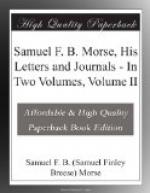All the details of these experiments have not been recorded, but I believe that at first an attempt was made to put into a more finished form the principle of the machine made by Morse, with its swinging pendulum tracing a waving line, but this was soon abandoned in favor of an instrument using the up-and-down motion of a lever, as drawn in the 1832 sketch-book. In other words, it was a return to first principles as thought out by Morse, and not, as some would have us believe, something entirely new suggested and invented independently by Vail.
It was rather unfortunate and curious, in view of Morse’s love of simplicity, that he at first insisted on using the dots and dashes to indicate numbers only, the numbers to correspond to words in a specially prepared dictionary. His arguments in favor of this plan were specious, but the event has proved that his reasoning was faulty. His first idea was that the telegraph should belong to the Government; that intelligence sent should be secret by means of a kind of cipher; that it would take less time to send a number than each letter of each word, especially in the case of the longer words; and, finally, that although the labor in preparing a dictionary of all the most important words in the language and giving to each its number would be great, once done it would be done for all time.
I say that this was unfortunate because the fact that the telegraphic alphabet of dots and dashes was not used until after his association with Vail has lent strength to the claims on the part of Vail’s family and friends that he was the inventor of it and not Morse. This claim has been so insistently, and even bitterly, made, especially after Morse’s death, that it gained wide credence and has even been incorporated in some encyclopedias and histories. Fortunately it can be easily disproved, and I am desirous of finally settling this vexed question because I consider the conception of this simplest of all conventional alphabets one of the grandest of Morse’s inventions, and one which has conferred great good upon mankind. It is used to convey intelligence not only by electricity, but in many other ways. Its cabalistic characters can be read by the eye, the ear, and the touch.
Just as the names of Ampere, Volta, and Watt have been used to designate certain properties or things discovered by them, so the name of Morse is immortalized in the alphabet invented by him. The telegraph operators all over the world send “Morse” when they tick off the dots and dashes of the alphabet, and happily I can prove that this is not an honor filched from another.
It is a matter of record that Vail himself never claimed in any of his letters or diaries (and these are voluminous) that he had anything to do with the devising of this conventional alphabet, even with the modification of the first form. On the other hand, in several letters to Morse he refers to it as being Morse’s. For instance, in a letter of April 20, 1848, he uses the words “your system of marking, lines and dots, which you have patented.” All the evidence brought forward by the advocates of Vail is purely hearsay; he is said to have said that he invented the alphabet.




